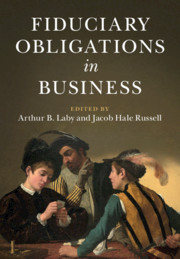14 results
5 - Which Investors to Protect?
- from Part I - Institutionalization and Investor Protection
-
-
- Book:
- The Cambridge Handbook of Investor Protection
- Published online:
- 20 October 2022
- Print publication:
- 27 October 2022, pp 95-114
-
- Chapter
- Export citation
Contributors
-
- Book:
- Fiduciary Obligations in Business
- Published online:
- 20 August 2021
- Print publication:
- 09 September 2021, pp ix-x
-
- Chapter
- Export citation
Editors’ Acknowledgments
-
- Book:
- Fiduciary Obligations in Business
- Published online:
- 20 August 2021
- Print publication:
- 09 September 2021, pp xi-xii
-
- Chapter
- Export citation
Part IV - Stakeholders and Society
-
- Book:
- Fiduciary Obligations in Business
- Published online:
- 20 August 2021
- Print publication:
- 09 September 2021, pp 283-349
-
- Chapter
- Export citation
13 - For Whom Are Nonprofit Managers Trustees? The Contractual Revolution in Charity Governance
- from Part III - Historical and Comparative Perspectives
-
-
- Book:
- Fiduciary Obligations in Business
- Published online:
- 20 August 2021
- Print publication:
- 09 September 2021, pp 241-260
-
- Chapter
- Export citation
Index
-
- Book:
- Fiduciary Obligations in Business
- Published online:
- 20 August 2021
- Print publication:
- 09 September 2021, pp 350-362
-
- Chapter
- Export citation
Introduction - The Decline and Rise of Fiduciary Obligations in Business
-
-
- Book:
- Fiduciary Obligations in Business
- Published online:
- 20 August 2021
- Print publication:
- 09 September 2021, pp 1-20
-
- Chapter
- Export citation
Part I - Identifying Fiduciaries and Their Duties
-
- Book:
- Fiduciary Obligations in Business
- Published online:
- 20 August 2021
- Print publication:
- 09 September 2021, pp 21-110
-
- Chapter
- Export citation
Contents
-
- Book:
- Fiduciary Obligations in Business
- Published online:
- 20 August 2021
- Print publication:
- 09 September 2021, pp vii-viii
-
- Chapter
- Export citation
Dedication
-
- Book:
- Fiduciary Obligations in Business
- Published online:
- 20 August 2021
- Print publication:
- 09 September 2021, pp v-vi
-
- Chapter
- Export citation
Part III - Historical and Comparative Perspectives
-
- Book:
- Fiduciary Obligations in Business
- Published online:
- 20 August 2021
- Print publication:
- 09 September 2021, pp 205-282
-
- Chapter
- Export citation
Part II - Gaps and Alternatives in Fiduciary Regimes
-
- Book:
- Fiduciary Obligations in Business
- Published online:
- 20 August 2021
- Print publication:
- 09 September 2021, pp 111-204
-
- Chapter
- Export citation
Copyright page
-
- Book:
- Fiduciary Obligations in Business
- Published online:
- 20 August 2021
- Print publication:
- 09 September 2021, pp iv-iv
-
- Chapter
- Export citation

Fiduciary Obligations in Business
-
- Published online:
- 20 August 2021
- Print publication:
- 09 September 2021

